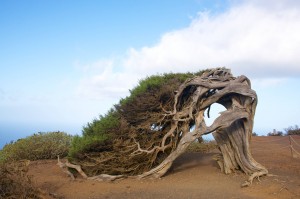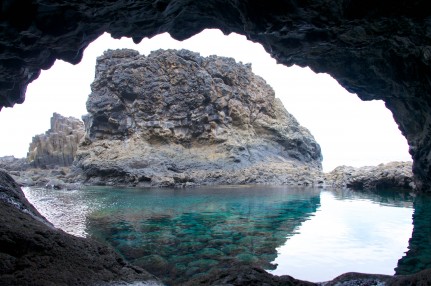El Hierro is the Canary Island that no one knows about. It’s authentic, undeveloped and for years was considered the end of the known world. Aaron Millar checks it out
For hundreds of years, before Columbus crossed the Atlantic, El Hierro, the smallest, most authentic and least developed of the Canary Islands, was the edge of the known world.
That feeling of remoteness is still palpable. As I hiked up to the summit of Malpaso, the highest peak on the island, I saw more goats than people (goats outnumber people almost two to one) and, at the top, with the thumping resorts of Tenerife only 100 miles away, it was silent enough to hear waves crashing on the Atlantic almost 5,000 feet below. Life, here on the periphery, has created a satisfyingly sparse brand of bliss. But remoteness also has a price: for the story of El Hierro is not told in numbers of tourists, but in drops of scarce and precious water.
It begins with drought. In 1741, after months without rain and with many of the islanders already dying, shepherds carried a statue of the Virgin Mary from the pasturelands of the south-west, over the highlands to the capital Valverde, in the north-east, to ask for rain. As they arrived the heavens – so to speak – opened and spared the population a terrible fate.
Since then, every four years the islanders repeat the Virgin’s arduous 18-mile pilgrimage – the Bajada de la Virgin de los Reyes (Descent of the Virgin of the Kings) – accompanied with music, costume, solemnity and celebration. For a small island – El Hierro is home to less than 11,000 people – it’s a big occasion: the 2013 procession purportedly attracted 25,000 revellers across five weeks of festivities.
I had come here on a new slow travel trip designed to follow the rough path of the pilgrimage. In doing so I hoped to walk a circumnavigation of this last outpost and discover, along the way, the echo of an authentic Canary Island culture that has changed little in centuries.
I set off in reverse, walking from the bright, windswept capital Valverde along the wide path of the procession, following it south onto higher ground, where black volcanic rocks and arid desert shrubs were replaced, suddenly, by lush, mossy forests of cypress and heather. I was headed to the sacred Garoé tree: the symbol of the island’s struggle for water, and – because divine intervention is a little erratic – also its solution.
“We call it horizontal rain,” Monica, a local guide, explained, and I was in the thick of it.
Like what you’re reading? Positive News depends on your support to publish quality inspiring content. Please donate to help us continue pioneering a more constructive news media.
When humid north-eastern trade winds, dense with moisture absorbed from the ocean, hit the mountains of El Hierro, they are forced to rise, and cool, forming a cloud that leaves tiny drops of water on the surrounding vegetation. The island’s early settlers survived, she explained, by digging holes in the impermeable clay soil beneath bushes and trees, and simply waiting for them to drip full. As I hiked down to El Garoé, sacred because of its water tank-like efficiency, the logic was clear, but the tree, sadly, was not: a dense white void of wind and cloud swirled between her spiral branches, obscuring her leaves as surely as it worked its magic.
From there I spent the next couple days exploring El Golfo: an enormous natural amphitheatre, encircled by 3,000-feet-high escarpments, and filled with small allotments, slumbering white-washed villages and plantations bursting with pineapples, mangos and bananas. At the Mirador de Bascos – the southernmost lookout point in Europe – I crawled on my belly to the edge of the cliff as kestrels hovered in the breeze beneath me. At the spectacular 2,000-feet-high restaurant, Mirador de la Pena, I ate sweet quesadillas – an island delicacy – and felt like I was dining on a cloud. At Charco Azul, I dived into natural sea pools, protected from the ocean by borders of slippery volcanic rock. Lying on my back in that warm turquoise water, sheltered from the raging ocean and cold crashing waves, was like floating in the eye of a storm.
Then a highlight: dinner at Noly’s House, the Casa de Comidas, a pop-up restaurant of unrivalled discreetness in the front room belonging to the Mayor of Valverde’s mother. Surrounded by pictures of her grandchildren, and with the sounds of Noly cooking happily in her kitchen next door, I ate a traditional Canary Island feast of puchero, seasonal soup and stew, with fresh figs and apple cake for pudding.
“If I’m cooking for my family,” Noly told me, “whoever knocks on my door is welcome to share.” Mummy Boris Johnson, take note.
This year El Hierro is set to become one of the world’s first 100% sustainable islands, powered solely by wind and hydroelectric power. In a remarkable turn of the story, it will be the same trade winds, the bringers of horizontal rain, that will power the desalination plant and provide water once again.
Later, as I walked among Bimbache (the original inhabitants of the island) caves, I learned that less than 50 years ago there was no widespread electricity. Houses were built and water was collected in much the same way as it had been for centuries, and shepherds today still move their flocks according to the seasonal needs of water. It was then I realised that sustainability isn’t a progressive attitude here, it’s the echo of ancient way of life that’s still present today.
“Even the young people are connected to the land,” Paolo, a local guide, told me. “In one hand they may have a smartphone but in the other they are still cultivating potatoes in the field.”
At the end of my trip I found myself at the start of the journey: a small stone chapel housing the statue of the Virgin until her pilgrimage begins from here anew, every four years. But even as the colour of the new day warmed my face, my mind was drawn back west, to that blue void of seamless sea and sky, beyond which only a few hundred years ago the world simply ceased to exist. I lifted my arms to that empty space and felt like I might float away.
Slow Holiday specialist Inntravel (www.inntravel.co.uk 01653 617000) offers a week’s self-guided walking on El Hierro from £798 per person based on two sharing including return flights from Tenerife North to El Hierro, seven nights’ bed and breakfast, five dinners, three picnics, luggage transfers between four different hotels, and walking route maps and notes. International flights (Tenerife South) are extra.
A version of this article first appeared in The Independent.
To see more photos from Aaron’s trip or talk to him directly about the experience, visit www.thebluedotperspective.com


